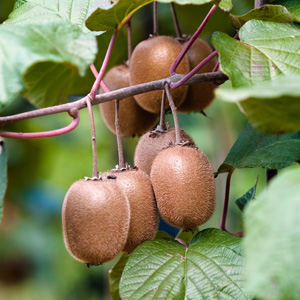Kiwifruit Growing Guide

What is Kiwifruit?
Kiwifruit (Actinidia deliciosa) also known as Chinese Gooseberry is a deciduous fruiting vine. It is part of the Actinidiaceae family and is native to China. Kiwifruit are dioecious plants, which means they need both male and female plants to pollinate. One male will pollinate up to five females however most gardens will only have one of each as they can take up a large space. They are a long lasting plant able to live and bear fruit for up to 20 + years. Once planted female vines take 4 to 5 years to mature before they will start bearing fruit. Kiwifruit is a deciduous vine that produces large plum shaped fruits that have furry green/brown skins and green pulp inside. Their leaves are oval, mid green and are also furry. The flowers are pale yellow and have five petals. Kiwifruit do best in climates with warm Summers and cool Winters with sufficient ‘chilling hours’. In warmer zones, look for ‘low chill’ varieties of kiwifruit that will still fruit successfully.
Kiwifruit produce fruit on current season’s growth that is growing from buds on one year old wood (previous season canes). Fruit is formed on the first 3 – 5 buds on the current seasons growth also known as fruiting spurs. Female plants produce fruit while male plants only produce flowers for pollination. Harvest fruit in Autumn while it is still firm and ripen at room temperature, or in a paper bag with an apple or banana. Plants lose their leaves in Winter and are frost hardy when dormant, but flowers and young tips may need some frost protection in early Spring. Kiwifruit vines prefer a full sun to part shade position in the garden that is protected from strong winds.
Benefits of Growing Kiwifruit
The Kiwifruit is a long-lived plant and grows vigorously. They can provide shade during Summer and let the sunlight in during Winter. Kiwifruit is an excellent source of vitamin C, potassium and calcium. They are packed with an array of nutrients, fibre and antioxidants. Kiwifruit are great eaten by themselves, in smoothies or in fruit salads.
How to Grow Kiwifruit
Climatic Zones
Cool, temperate, arid.
Plant Size
Height: 5-10m, Width: 5-10m
When To Plant Kiwifruit
Plant anytime.
Soil Preparation
They like a moist, well drained and slightly acidic soil. Prepare your soil by adding compost and well broken down manure.
How To Plant Kiwifruit
Plant in full sun, with the plant crown at soil level.
The vine is best planted facing North or where it can get 4 to 6 hours of direct Summer sunlight it needs to ripen the fruit. Make sure that it is protected from strong winds.
Dig the planting hole twice as wide and to the same depth as the root-ball.
Kiwifruit need something strong to grow on such as a fence, pergola or trellis.
Kiwifruit Plant Care
Water well during the growing season, especially once flowers start setting fruit. Kiwifruits dislike having wet feet. Try to avoid over watering and ensure that the soil is well draining.
Mulch annually to retain moisture, suppress weeds and add nutrients.
Kiwifruit need to be fertilised regularly, at least twice a year in Spring and Autumn. A complete fertiliser or well broken down animal manure is ideal.
When pruning each year, maintain a central trunk, and some strong horizontal arms. Remember that fruiting spurs will grow off one year old growth. Remove any tips that flop too far from your frame. Prune laterals back to 2 or 3 buds beyond previous seasons crop. If overcrowding occurs you can remove some laterals completely. If the vines grow too quickly in Summer, prune back the growth. If any laterals become broken of diseased remove them. Prune male plants after flowering.
Tips: It is impossible to tell the male and female plants apart when not in flower so it is recommended to prune the male plant as soon as it has finished flowering.
Protect your kiwifruits from possums and birds by placing a net over your vines during fruiting time.







